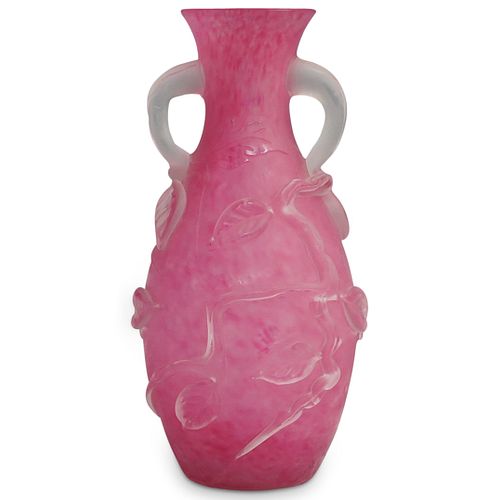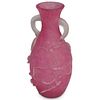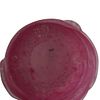Steuben Rose Quartz Vase
Lot 118
About Seller
Akiba Antiques
3 N Federal Hwy
Dania Beach, FL 33004
United States
Akiba Antiques, founded by Charles and Franceska Akiba in the 1980’s in Paris, France started by buying and selling fine arts. Franceska specialized in French furniture from the fine Napoleonic Era to La Belle Epoque, to Art Nouveau and Art Deco; While Charles’ expertise lied in European paintings b...Read more
Categories
Estimate:
$1,000 - $5,000
Absentee vs Live bid
Two ways to bid:
- Leave a max absentee bid and the platform will bid on your behalf up to your maximum bid during the live auction.
- Bid live during the auction and your bids will be submitted real-time to the auctioneer.
Bid Increments
| Price | Bid Increment |
|---|---|
| $0 | $20 |
| $500 | $50 |
| $1,000 | $100 |
| $2,000 | $250 |
| $5,000 | $500 |
| $10,000 | $1,000 |
| $25,000 | $2,500 |
| $50,000 | $5,000 |
| $100,000 | $10,000 |
| $250,000 | $25,000 |
About Auction
By Akiba Antiques
Jul 29, 2021
Set Reminder
2021-07-29 12:00:00
2021-07-29 12:00:00
America/New_York
Bidsquare
Bidsquare : The Marvelous Collection of Mr & Mrs Shovers
https://www.bidsquare.com/auctions/akiba-antiques/the-marvelous-collection-of-mr-mrs-shovers-7184
The collection of Alan and Susan Shovers offers one of the rarest selections of Steuben glass available. Alan and Susan are both experts in the field - together, they authored the book "Objects of Desire: The Art of Frederick Carder" Akiba Antiques info@akibaantiques.com
The collection of Alan and Susan Shovers offers one of the rarest selections of Steuben glass available. Alan and Susan are both experts in the field - together, they authored the book "Objects of Desire: The Art of Frederick Carder" Akiba Antiques info@akibaantiques.com
- Lot Description
DESCRIPTION: Steuben Rose Quartz vase features baluster form cut with a design of leaves and flowers in cameo on an acid finished ground with applied carved satin handles and large entwining vine.
Shape 6766, p.285 Gardner
Engraved f-d-l on side at bottom.
Reference:
Full page picture p. 78 of Frederick Carder: Portrait of a Glassmaker by Paul V. Gardner where the caption reads: Rose Quartz vase, Reminiscent of Cintra and Moss Agate, the Quartz glasses (made in several colors) combined an inner layer of crackled Crystal covered by finely powdered Ruby, both enclosed in a Crystal casing ornamented with tooled Crystal leaves and stems. After annealing, an acid-etched decoration was added, and the entire exterior was give a satin finish with buffed highlights. Late 1920s
Pictures at p. 153 of American Art Glass by John A. Shuman III.
Shown in Fig. 4.20, p. 48 of Frederick Carder and Steuben Glass by Thomas P. Dimitroff.
In The Glass of Frederick Carder by Paul V. Gardner at Ill. 122 p. 80 Gardner describes Rose Quartz as crackled inside and satin finish has polished highlights and c. 1930. The author states: This glass resembles the mineral for which it was named, but in basic production technique it is similar to Cintra. Usually it was made in heavy glass forms about one-quarter to three-eighths of an inch in thickness. In addition to the powdered glass that gave the object its color, a crackled effect was added.
A bowl pictured Fig. 12, p. 46 of Steuben Seventy Years of American Glassmaking by Perrot, Gardner, Plaut described the technique. This rare bowl demonstrates a combination of several glassmaking techniques. The mottled amethyst color is from powdered glass Picked up from the marver in the same technique as that used in producing Cintra pieces. The leaves and feet are of crystal applied At the fire and are tooled while the glass is still hot to give the effect of veinings and bark. After the piece is annealed, the floral design in low relief is acid-etched and the entire surface and applied decorations given a satin finish with buffed highlights.
Factory records show this piece priced at $25. “Crystal sculptured”.
Pictured in Number 54 (Oct-Dec., 1998) of Collectors Choice Review Thomas P. Dimitroff states: (Quartz) is composite, resulting from the application of many glassmaking skills and techniques. The glass itself is cased and includes trapped particles much in the same vein as Carders Cintra, Cluthra, Lace Glass, and Florentia. The base glass is also crackled. The vase boasts wonderful applied decoration reminiscent of Venetian embellishments; yet, the leaves and vines undulate with a rhythm more attuned to the world of Art Nouveau. Once applied, these decorative elements have been fumed with acid to produce a smooth, satiny visual effect. Finally, the body of the piece itself has been acid-etched carrying further the floral theme of the piece. Pieces like this are magnificent examples of the design, workmanship, and quality of the glass produced at Steuben by Frederick Carder. These pieces also remind us of the unbroken tradition and skills of generations of glassmakers both here and abroad.
Provenance:
Estate of Mr. and Ms. Alan Shovers
Acquired 5/7/07 from Richard Stark of Potomac, MD
CIRCA: 1930-1932
DIMENSIONS: H11.5" W:6"
CONDITION: Great Condition. See lot description for details on item condition. More detailed condition requests can be obtained via email (info@akibaantiques.com) or SMS 305-332-9274. Any condition statement given, as a courtesy to a client, is only an opinion and should not be treated as a statement of fact. Akiba Antiques shall have no responsibility for any error or omission. - Shipping Info
-
For shipping please contact our 3rd party shipper: UPS STORE 954 4541131 auctions1937@gmail.com Contact Name:David
-
- Payment & Auction Policies
-
Available payment options
Thank you and congratulations on your new purchase!
-
-
- Buyer's Premium



 EUR
EUR CAD
CAD AUD
AUD GBP
GBP MXN
MXN HKD
HKD CNY
CNY MYR
MYR SEK
SEK SGD
SGD CHF
CHF THB
THB


























